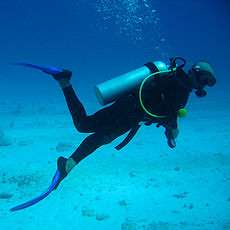Task loading
Task loading in scuba diving is a term used to refer to a multiplicity of responsibilities leading to an increased risk of failure on the part of the diver to undertake some key basic function which would normally be routine for safety underwater.[1][2]
Common examples
Common examples of activities which can cause task loading are:
- underwater photography or videography[3]
- underwater search and recovery
- underwater mapping
- diving in environments requiring use lights or guide reels (such as night diving, wreck diving and cave diving) or other additional equipment
- use of drysuits
- driving a Diver Propulsion Vehicle (DPV)
- diving in cold water[4]
- breathing narcotic gas mixture[5]
Task loading represents an elevated risk when a new activity is undertaken by an inexperienced diver. A diver learning how to use a drysuit, or starting underwater photography, will need to dedicate considerably more attention to the proper functioning of the new and unfamiliar piece of equipment which leads to the elevated risk of neglect of other responsibilities. Those risks will normally diminish with experience.
Common examples of routine functions that can be overlooked as a result of task loading are:
- monitoring air supply properly
- maintaining buddy contact
- maintaining proper buoyancy[nb 1]
- monitoring depth and time (no-decompression limits)
- monitoring oxygen partial pressure in a rebreather
Task loading is often identified as a key component in diving accidents, although statistically it is difficult to monitor because divers of differing levels of experience can cope with a more complex array of tasks and equipment.[6] Whilst simply getting used to using a drysuit can call for great levels of attention in an inexperienced diver, it would be a routine piece of equipment for an experienced technical diver to use, whilst carrying a camera and also penetrating a cave or wreck at depth or using a DPV.
See also
References
- ↑ Blumenberg, MA (1996). "Human Factors in Diving.". CALIFORNIA UNIV BERKELEY (ADA322423). Retrieved 2008-07-05.
- ↑ Lorenz J, Lorenz B, Heineke M (July 1992). "Effect of mental task load on fronto-central theta activity in a deep saturation dive to 450 msw". Undersea Biomedical Research. 19 (4): 243–62. PMID 1353926. Retrieved 2008-07-05.
- ↑ Kagan, Becky (2009-05-16). "Task Loading Tips For Underwater Photographers & Videographers". DivePhotoGuide.com. Retrieved 2009-05-16.
- ↑ Vaughan WS (June 1977). "Distraction effect of cold water on performance of higher-order tasks". Undersea Biomedical Research. 4 (2): 103–16. PMID 878066. Retrieved 2008-07-05.
- ↑ Biersner, RJ & Cameron, BJ (1970). "Cognitive Performance during a 1000-Foot Helium Dive.". United States Navy Experimental Diving Unit Technical Report (NEDU-RR-10-70). Retrieved 2008-07-05.
- ↑ O'Connor PE (2007). "The nontechnical causes of diving accidents: can U.S. Navy divers learn from other industries?". Undersea and Hyperbaric Medicine. 34 (1): 51–9. PMID 17393939. Retrieved 2008-07-05.
Footnotes
- ↑ This is identified in most training courses as a common failing amongst new underwater photographers and underwater videographers
